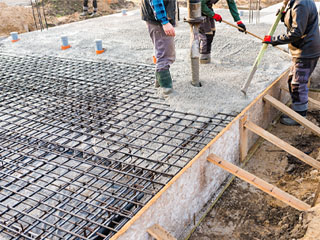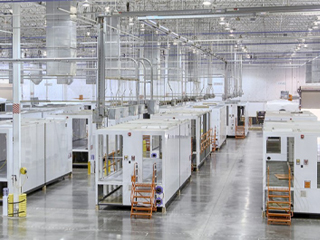The demand for large data storage and computing capacity places data centers at a crossroads. It continuously grows as an effect of the Covid-19 pandemic across the globe. The nationwide lockdown imposed by the government increased the demand for internet access. Cloud-based services paved the way for accessing, transferring, and storing information among organizations. In some cases, the cooling units provide two times more air than what the heat loads need at off-peak loads.
In this situation, instead of setting the air conditioner at its peak, using liquid air cooling can leverage efficiency. One of the ways this can be achieved is through the use of a Rear-Door Heat Exchanger. Since 2009, it has been widely used inside the server racks to remove heat when it exceeds the CRAC’s capability.
What is a Rear-Door Heat Exchanger?
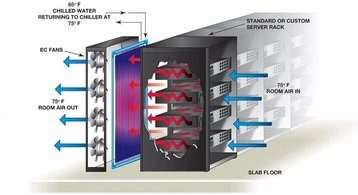
Photo Credit: motivair.com
The Rear-Door Heat Exchanger is ideal for supporting high-density data centers. The radiator-like doors are mounted at the back of the racks. It can cool a 20kW rack at standard chilled water design temperatures. The server exhausts hot air through the heat exchanger. The heated liquid then travels to the cooling towers linked to an external chilled water system. This will cool the air back to the data center space.
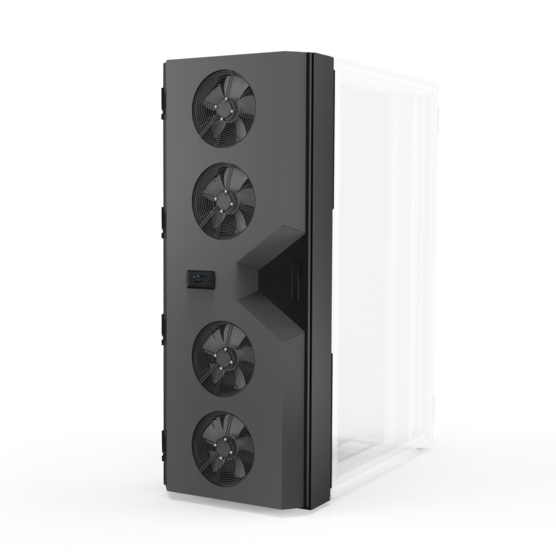
Photo Credit: hoffman.nvent.com
This solution can be easily implemented as there is no need for raised floors and air handlers. However, it requires professional skills for space design and CFD analysis to visualize it. This may also be a less practical option for data centers consuming only 3-10 kWh per rack.
The Rear-Door Heat Exchanger can be configured in two ways – Active or Passive cooling solution.
This system provides cooling without the use of any equipment. CRAC units are not necessary for maintaining the optimum environment. These are placed at the rear of the cabinets absorbing the heat and removing it through the chilled water system. For data centers with insufficient cooling airflow, this can be a viable solution. It can produce a maximum of 5400 m3 per hour of airflow while only using 300W of power.
-
Passive RDHX
Passive RDHX has no moving part, so it is highly dependent on the airflow provided by the server fans within the cabinet. The pressure and temperature within the cabinet is a critical aspect to consider in this solution. Too much volume of airflow at the rear door can increase head pressure load on the server fans. This pressure head can create sealing of all potential air pathways resulting in air recirculation. The use of AKCP cabinet analysis sensor can identify issues where pressure is not correct and alert so action can be taken.
The Benefits of Rear-Door Heat Exchanger
A Rear-Door Heat Exchanger has the following benefits for high-performing data centers. Facilities with the right qualification can take advantage of the solution by implementing it:
1. Energy Efficiency
One of the major benefits of using RDHX is significant energy savings. It can save up to 80% of cooling on the racks and 50% on the overall data center operation. For instance, the active device can run more energy efficiently, with the door being the main air extraction method. The heat is removed quicker, so fans and chiller will not use much power as the temperature rises.
2. Heat Removal
Heat transfer is more extensive since it is very close to the heat source. This makes it a good option for high-density data centers. It can reduce the server outlet air temperature by 10°F, removing 48% of the waste heat.
3. Less Space Requirement
A common dilemma for data centers is the limited space. Slim rear-door heat exchangers are available in the market using up minimum floor spaces. Deployment of huge unnecessary CRAC units on a space-constrained facility is not workable. Instead of putting more equipment when rack density grows, scaling the cooling with this system can be a better option.
4. Flexibility
RDHX is a cost-effective cooling solution for both existing and newly designed data centers. It has a more basic operation and is easier to install compared to CRAC units with under-floor air distribution. The UFAD system has an added cost range of 5-7 $/ft2 for the ductwork, electrical services, and downsizing of some mechanical equipment. This excludes the maintenance cost while operating to prevent air leakage.
5. Low maintenance
The Rear-Door Heat Exchanger requires lower maintenance. It needs to be cleaned once in a while to remove the dirt on the air-side of the coils. Several methods are used to perform it, such as acid cleaning, sandblasting, high-pressure water jet, bullet cleaning, or drill rods. Another consideration is proper waterside maintenance.
The Drawbacks of Rear-Door Heat Exchanger
Although the study shows that this system supports large computing facilities, some are still not adopting it. Google, Amazon, and Network Appliance are not open to integrating this system into their data center as they don’t realize they need “highly-dense fast infrastructures.”
Jason Black sees this as a solution that lacks flexibility for Colocation Data Centers. Pipes that are connected with the cabinets are part of the solution. This makes it difficult for the admin to re-design the space for new customers. Another issue is the liquid may cause problems within the facility. As it is known, the combination of water and electricity is catastrophic.
Designing Data Center into RDHX System
Before designing the data center into the RDHX System, administrators need to be aware of the measures. This allows the solution to achieve utmost effectiveness and prevent complications later on. The site and equipment also need to be prepared for changes before implementation.

- Server Rack Assessment ensures safety from air leakage. Fillers can be put into the spaces to prevent air recirculation and short circuit. These issues can cause the development of hotspots to damage the equipment. Blanking panels provide a clean and professional look by covering space and hiding visible cables.
- Proper arrangement of floor tiles is also critical to prevent disrupted airflow. Objects that obstruct the air need to be eliminated or moved into another position.
- Although the hot and cold aisle containment system is not a prerequisite of RDHX, it can also contribute to the total efficacy of the solution. This configuration conserves energy by up to 60% by isolating hot and cold air from each other.
- Even a small increase in the set point can result in significant energy savings in the facility. Cooling units work to maintain the set-point. A higher set point means less power consumed by the unit.
Consistent Monitoring in RDHX System
The Lawrence Berkley National Laboratory (LBNL) encountered notable issues during the case study using the Passive RDHX System. It produced an unrestricted amount of cooling within the data center. Administrators need to coordinate the cooling capacity of the system with the standard CRAC units. Systems should be adjusted to supply only the necessary amount of cooling. Air leakage may also happen on the rear door if they are not fit tightly. This emphasizes the need for a monitoring system when implementing new designs. Using an airflow sensor, it is possible to track the airflow and the pressure within the cabinets. This guarantees a successful project.
Another perimeter to keep track of is the temperature. It is important to measure before and after retrofitting the data center. Temperature sensors are placed in the coil’s inlet and outlet to prevent overheating and provide an effective failsafe. It also ensures that the facility is at the right temperature to maximize energy efficiency. LBNL recommends a range between 74°F to 78°F – mid-range of the limit set by the ASHRAE. This range conserves energy since mechanical cooling is limited. It will prevent the servers’ circulation fans from speeding up to meet the proper chip cooling.
AKCP Monitoring Sensors
Sensors are integrated into monitoring systems to observe airflow, pressure, and temperature at a given interval. It provides accurate data to help administrators to make the most informed decisions. Notifications are sent when these parameters exceed the set-point preventing the occurrence of huge problems. This allows the team to apply the standard measures with enough time.
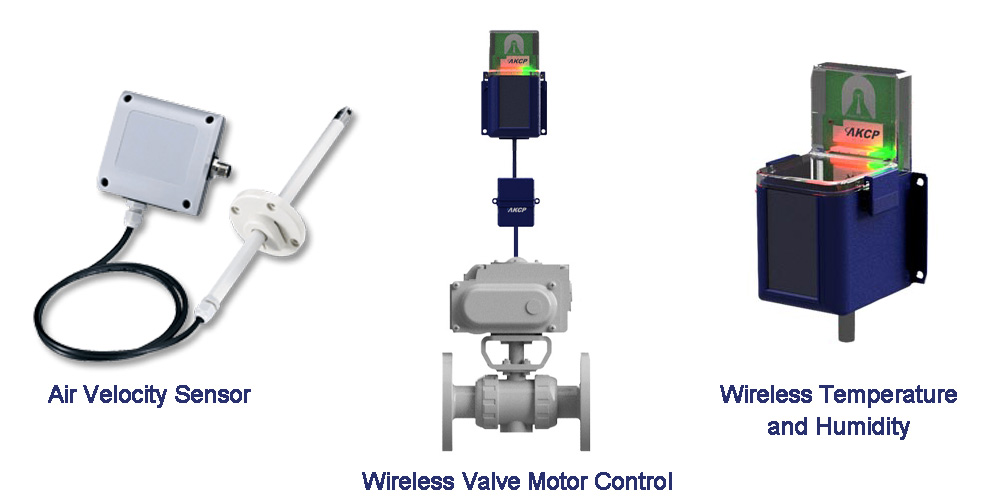
AKCP Sensor Solutions
Air Velocity Sensor
The AKCP Air Velocity Sensor is designed for systems that generate heat, and a steady flow of air is necessary to dissipate this in order to maintain system reliability and safety.
In the Air Velocity Transmitter sensor is employed to monitor the airside of the cooling system. This is where the user can monitor the status and the amount of flowing air. In addition to an on/off indication, it also graphs the analog values over a period of time. If, for example, the airflow decreases the web interface will show an indication of change over time.
In addition to the web interface readings, the sensor has its own SNMP OID for alarm/normal status and to get the current analog value. SNMP traps are sent when critical. Polling via SNMP get is also available.
Wireless Valve Motor Control
Wireless, remote monitoring, and control of motorized ball valves in your water distribution network. Check status and remotely actuate the valves. Receive alerts when valves open and close, or automate the valve based on other sensor inputs, such as pressure gauges or flow meters.
Wireless Temperature and Humidity
References:
https://www.datacenterknowledge.com/archives/2017/05/22/rdhx-systems-help-with-high-density-data-center-cooling
https://datacenters.lbl.gov/sites/all/files/rdhx-doe-femp.pdf
https://www.opencompute.org/documents/acs-door-hx-open-compute-requirements-for-open-rack-rev0-95-1-pdf
https://www.missioncriticalmagazine.com/ext/resources/whitepapers/shlomo-WP-RDHx-Cost-Effective-Alternative-to-CRAH-120811.pdf
https://www.vertiv.com/49cfee/globalassets/shared/liebert-dcd-passive-and-active-brochure_0.pdf


